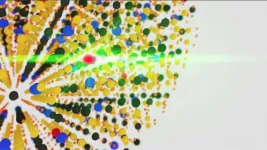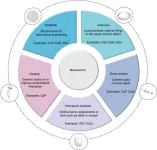(Press-News.org) New York, NY—January 1, 2025—Mechanical force is an essential feature for many physical and biological processes. Remote measurement of mechanical signals with high sensitivity and spatial resolution is needed for a wide range of applications, from robotics to cellular biophysics and medicine and even to space travel. Nanoscale luminescent force sensors excel at measuring piconewton forces, while larger sensors have proven powerful in probing micronewton forces. However, large gaps remain in the force magnitudes that can be probed remotely from subsurface or interfacial sites, and no individual, non-invasive sensor has yet been able to make measurements over the large dynamic range needed to understand many systems.
New, highly responsive nanoscale sensors of force
In a paper published today by Nature, a team led by Columbia Engineering researchers and collaborators report that they have invented new nanoscale sensors of force. They are luminescent nanocrystals that can change intensity and/or color when you push or pull on them. These "all-optical" nanosensors are probed with light only and therefore allow for fully remote read-outs -- no wires or connections are needed.
The researchers, led by Jim Schuck, associate professor of mechanical engineering, and Natalie Fardian-Melamed, a postdoctoral scholar in his group, along with the Cohen and Chan groups at Lawrence Berkeley National Lab (Berkeley Lab), developed nanosensors that have attained both the most sensitive force response and largest dynamic range ever realized in similar nanoprobes. They have 100 times better force sensitivity than the existing nanoparticles that utilize rare-earth ions for their optical response, and an operational range that spans more than four orders of magnitude in force, a much larger range -- 10-100 times larger -- than any previous optical nanosensor.
“We expect our discovery will revolutionize the sensitivities and dynamic range achievable with optical force sensors, and will immediately disrupt technologies in areas from robotics to cellular biophysics and medicine to space travel,” Schuck says.
New nanosensors can operate in previously inaccessible environments
The new nanosensors achieve high-resolution, multiscale function with the same nanosensor for the first time. This is important as it means that just this nanosensor, rather than a suite of different classes of sensors, can be employed for the continuous study of forces, from the subcellular to the whole-system level in engineered and biological systems, such as developing embryos, migrating cells, batteries, or integrated NEMS, very sensitive nanoelectromechanical systems in which the physical motion of a nanometer-scale structure is controlled by an electronic circuit, or vice versa.
“What makes these force sensors unique – apart from their unparalleled multiscale sensing capabilities – is that they operate with benign, biocompatible, and deeply penetrating infrared light," Fardian-Melamed says. “This allows one to peer deep into various technological and physiological systems, and monitor their health from afar. Enabling the early detection of malfunction or failure in these systems, these sensors will have a profound impact on fields ranging from human health to energy and sustainability.”
Using the photon-avalanching effect to build the nanosensors
The team was able to build these nanosensors by exploiting the photon-avalanching effect within nanocrystals. In photon-avalanching nanoparticles, which were first discovered by Schuck’s group at Columbia Engineering, the absorption of a single photon within a material sets off a chain reaction of events that ultimately leads to the emission of many photons. So: one photon is absorbed, many photons are emitted. It is an extremely nonlinear and volatile process that Schuck likes to describe as "steeply nonlinear,’ playing on the word “avalanche.”
The optically active components within the study’s nanocrystals are atomic ions from the lanthanide row of elements in the periodic table, also known as rare-earth elements, which are doped into the nanocrystal. For this paper, the team used thulium.
Team investigates a surprising observation
The researchers found that the photon avalanching process is very, very sensitive to several things, including the spacing between lanthanide ions. With this in mind, they tapped on some of their photon avalanching nanoparticles (ANPs) with an atomic force microscopy (AFM) tip, and discovered that the avalanching behavior was greatly impacted by these gentle forces -- much more than they had ever expected.
“We discovered this almost by accident,” Schuck says. “We suspected these nanoparticles were sensitive to force, so we measured their emission while tapping on them. And they turned out to be way more sensitive than anticipated! We actually didn't believe it at first; we thought the tip may be having a different effect. But then Natalie did all the control measurements and discovered that the response was all due to this extreme force sensitivity.”
Knowing how sensitive the ANPs were, the team then designed new nanoparticles that would respond to forces in different ways. In one new design, the nanoparticle changes the color of its luminescence depending on the applied force. In another design, they made nanoparticles that do not demonstrate photon avalanching under ambient conditions, but do begin to avalanche as force is applied -- these have turned out to be extremely sensitive to force.
Collaborative effort with Lawrence Berkeley National Lab
For this study, Schuck, Fardian-Melamed, and other members of the Schuck nano-optics team worked closely with a team of researchers at the Molecular Foundry at Lawrence Berkeley National Lab (Berkeley Lab) headed by Emory Chan and Bruce Cohen. The Berkeley lab team developed the custom ANPs based on the feedback from Columbia, synthesizing and characterizing dozens of samples to understand and optimize the particles’ optical properties.
What’s next
The team now aims to apply these force sensors to an important system where they can achieve significant impact, such as a developing embryo, like those studied by Columbia’s Mechanical Engineering Professor Karen Kasza. On the sensor design front, the researchers are hoping to add self-calibrating functionality into the nanocrystals, so that each nanocrystal can function as a standalone sensor. Schuck believes this can easily be done with the addition of another thin shell during nanocrystal synthesis.
“The importance of developing new force sensors was recently underscored by Ardem Patapoutian, the 2021 Nobel Laureate who emphasized the difficulty in probing environmentally sensitive processes within multiscale systems – that is to say, in most physical and biological processes. (Nature Reviews Mol. Cell Biol. 18, 771 (2017)),” Schuck notes. “We are excited to be part of these discoveries that transform the paradigm of sensing, allowing one to sensitively and dynamically map critical changes in forces and pressures in real-world environments that are currently unreachable with today’s technologies.
About the Study
Journal: Nature
The study is titled “Infrared nanosensors of piconewton to micronewton forces.”
Authors are: Natalie Fardian-Melamed1*, Artiom Skripka2,3, Benedikt Ursprung1, Changhwan Lee1, Thomas P. Darlington1, Ayelet Teitelboim2, Xiao Qi2, Maoji Wang4, Jordan M. Gerton4, Bruce E. Cohen2,5, Emory M. Chan2, P. James Schuck1
1Department of Mechanical Engineering, Columbia University
2The Molecular Foundry, Lawrence Berkeley National Laboratory
3Nanomaterials for Bioimaging Group, Departamento de Física de Materiales, Facultad de Ciencias, Universidad Autόnoma de Madrid
4Department of Physics and Astronomy, University of Utah
5Division of Molecular Biophysics and Integrated Bioimaging, Lawrence Berkeley National Laboratory,
Acknowledgements: N.F.-M. gratefully acknowledges support from the European Union's Horizon 2020 research and innovation program under the Marie Skłodowska-Curie grant agreement No. 893439, the US Department of State Fulbright Scholarship Program, the Zuckerman-CHE STEM Leadership Program, the Israel Scholarship Education Foundation (ISEF) International Fellowship Program, and the Weizmann Institute’s Women’s Postdoctoral Career Development Award. B.U. and P.J.S. acknowledge support by the National Science Foundation under grant no. CHE-2203510. A.S. acknowledges the support from the European Union's Horizon 2020 research and innovation program under the Marie Skłodowska-Curie grant agreement No. 895809 (MONOCLE). Work at the Molecular Foundry was supported by the Office of Science, Office of Basic Energy Sciences, of the US Department of Energy under contract number DE-AC02-05CH11231. X.Q., B.E.C., and E.M.C. were supported in part by the Defense Advanced Research Projects Agency (DARPA) ENVision program under contract HR0011257070, and C.L. and P.J.S. under DARPA ENVision contract HR00112220006. T.P.D. and P.J.S. also acknowledge support for the scan-probe measurements from Programmable Quantum Materials, an Energy Frontier Research Center funded by the US DOE, Office of Science, Basic Energy Sciences (BES), under award DE-SC0019443.
The authors declare no financial or other conflicts of interest.
###
LINKS:
Paper: https://www.nature.com/articles/s41586-024-08221-2
DOI: 10.1038/s41586-024-08221-2
###
END
A tour de force: Columbia engineers discover new “all-optical” nanoscale sensors of force
Photon-avalanching nanosensors access previously unreachable environments and could disrupt technologies from robotics to cellular biophysics and medicine to space travel
2025-01-01
ELSE PRESS RELEASES FROM THIS DATE:
Ancient DNA unlocks new understanding of migrations in the first millennium AD
2025-01-01
Francis Crick Institute press release
Under strict embargo: 16:00 GMT Wednesday 1 January 2025
Peer reviewed
Observational study
Ancient people
Ancient DNA unlocks new understanding of migrations in the first millennium AD
Waves of human migration across Europe during the first millennium AD have been revealed using a more precise method of analysing ancestry with ancient DNA, in research led by the Francis Crick Institute.
Researchers can bring together a picture of how people moved across the world by looking at changes in their DNA, but this becomes a lot harder when historical ...
MIT scientists pin down the origins of a fast radio burst
2025-01-01
Fast radio bursts are brief and brilliant explosions of radio waves emitted by extremely compact objects such as neutron stars and possibly black holes. These fleeting fireworks last for just a thousandth of a second and can carry an enormous amount of energy — enough to briefly outshine entire galaxies.
Since the first fast radio burst (FRB) was discovered in 2007, astronomers have detected thousands of FRBs, whose locations range from within our own galaxy to as far as 8 billion light-years away. Exactly how ...
Researchers reveal why the lung is a frequent site of cancer metastasis
2025-01-01
Leuven, 2 January 2024 – Researchers from the lab of Prof. Sarah-Maria Fendt (VIB-KU Leuven) and colleagues have uncovered that the availability of the amino acid aspartate is one reason why the lung is a frequent organ of metastasis. Their work appears in Nature and improves our understanding of cancer biology while providing the foundation for new therapeutic interventions in metastatic diseases.
A role for aspartate
More than half of cancer patients in whom the cancer spreads beyond the primary site have lung metastases. What makes the lungs such a ...
Aging may change some brain cells more than others
2025-01-01
EMBARGOED FOR RELEASE: Jan. 1, 2025, 11 a.m. ET
CONTACT:
NIAPressTeam@mail.nih.gov, 301-496-1752
Aging may change some brain cells more than others
NIH-funded mouse study provides roadmap for how aging may alter brain cell genetic activity
Based on new brain mapping research funded by the National Institutes of Health (NIH), scientists have discovered that not all cell types in the brain age in the same way. They found that some cells, such as a small group of hormone-controlling cells, may undergo more age-related changes in genetic activity than others. The results, published ...
Special issue of APA’s official journal focuses on psychedelic medication
2025-01-01
WASHINGTON, D.C., Jan. 1, 2025—As the body of research grows around the potential promise of psychedelic medications in psychiatry, many questions and challenges remain. The January issue of the American Journal of Psychiatry features a series of articles, including new research, reviews and commentaries, on the use of these treatments.
The issue addresses many of the ongoing challenges and looming questions in the field of psychiatric psychedelic research and treatment. These include issues relevant to basic ...
Geneticist unlocks mysteries of childhood psychiatric disorders through innovative research
2024-12-31
TORONTO, Ontario, Canada, 31 December 2024 - In a comprehensive Genomic Press Interview, leading geneticist Dr. Cathy Barr unveils crucial discoveries about the complex interplay between genes and childhood psychiatric disorders. As a Senior Scientist at both the Hospital for Sick Children and Krembil Research Institute, Dr. Barr's research illuminates the genetic foundations of conditions including depression, attention-deficit/hyperactivity disorder, reading disabilities, and Tourette syndrome.
"After decades of searching ...
New study uncovers key insights into protein interactions in Duchenne muscular dystrophy, paving way for more targeted therapies
2024-12-31
AURORA, Colo. (Dec. 31, 2024) – A groundbreaking study has shed light on the complex interactions between dystrophin, a protein critical to muscle stability, and its partner protein, dystrobrevin, offering new pathways for understanding and treating Duchenne Muscular Dystrophy (DMD).
Published in the December issue of the Journal of Biological Chemistry, researchers characterize the mysterious C-terminal (CT) domain of dystrophin and its role in stabilizing cellular membranes across various tissues.
DMD, a severe genetic disorder that causes muscle weakness and shortens lifespans, arises from mutations in the gene encoding ...
Revolutionizing fragrance design using deep neural networks (DNNs) scent profiles from chemical data
2024-12-31
Scientific research explores the potential of DNNs in transforming fragrance design. By analyzing the sensing data of 180 essential oils, the DNN was trained using the odor descriptor data from 94 essential oils to generate fragrance profiles, validated through sensory evaluations to align with human olfactory perceptions. The study underscores the technological ability to streamline fragrance creation, reduce costs, and foster innovation, opening up exciting possibilities for personalized and scalable scent development.
Deep Neural Networks (DNNs) have become an essential driver of innovation across various industries, ...
Custom-fit bone grafts: the future of craniomaxillofacial surgery
2024-12-31
A recent review is transforming the landscape of craniomaxillofacial bone regeneration with the introduction of personalized bioceramic grafts. This pioneering research explores the fabrication and clinical potential of synthetic grafts created through additive manufacturing (AM), addressing key limitations of traditional autogenous grafts. By focusing on 3D-printed bioceramics tailored to meet individual patient needs, the study marks a significant advancement in both precision medicine and patient-specific care, offering new hope for those requiring bone reconstruction.
Craniofacial bone defects, resulting from trauma, congenital conditions, or surgical ...
A new ‘molecular lantern’ detects brain metastasis in mice by inserting a probe thinner than a hair into the brain
2024-12-31
Monitoring the changes caused in the brain at the molecular level by cancer and other neurological pathologies in a non-invasive way is one of the great challenges of biomedical research. A new technique, still in the experimental stage, achieves this by introducing light into the brains of mice using a very thin probe. The innovation, which is published today in the journal Nature Methods, is ledby an international team including groups from the Spanish National Research Council (CSIC) and the Spanish National Cancer Research ...
LAST 30 PRESS RELEASES:
Numbers in our sights affect how we perceive space
SIMJ announces global collaborative book project in commemoration of its 75th anniversary
Air pollution exposure and birth weight
Obstructive sleep apnea risk and mental health conditions among older adults
How talking slows eye movements behind the wheel
The Ceramic Society of Japan’s Oxoate Ceramics Research Association launches new international book project
Heart-brain connection: international study reveals the role of the vagus nerve in keeping the heart young
Researchers identify Rb1 as a predictive biomarker for a new therapeutic strategy in some breast cancers
Survey reveals ethical gaps slowing AI adoption in pediatric surgery
Stimulant ADHD medications work differently than thought
AI overestimates how smart people are, according to HSE economists
HSE researchers create genome-wide map of quadruplexes
Scientists boost cell "powerhouses" to burn more calories
Automatic label checking: The missing step in making reliable medical AI
Low daily alcohol intake linked to 50% heightened mouth cancer risk in India
American Meteorological Society announces Rick Spinrad as 2026 President-Elect
Biomass-based carbon capture spotlighted in newly released global climate webinar recording
Illuminating invisible nano pollutants: advanced bioimaging tracks the full journey of emerging nanoscale contaminants in living systems
How does age affect recovery from spinal cord injury?
Novel AI tool offers prognosis for patients with head and neck cancer
Fathers’ microplastic exposure tied to their children’s metabolic problems
Research validates laboratory model for studying high-grade serous ovarian cancer
SIR 2026 delivers transformative breakthroughs in minimally invasive medicine to improve patient care
Stem Cell Reports most downloaded papers of 2025 highlight the breadth and impact of stem cell research
Oxford-led study estimates NHS spends around 3% of its primary and secondary care budget on the health impacts of heat and cold in England
A researcher’s long quest leads to a smart composite breakthrough
Urban wild bees act as “microbial sensors” of city health.
New study finds where you live affects recovery after a hip fracture
Forecasting the impact of fully automated vehicle adoption on US road traffic injuries
Alcohol-related hospitalizations from 2016 to 2022
[Press-News.org] A tour de force: Columbia engineers discover new “all-optical” nanoscale sensors of forcePhoton-avalanching nanosensors access previously unreachable environments and could disrupt technologies from robotics to cellular biophysics and medicine to space travel






